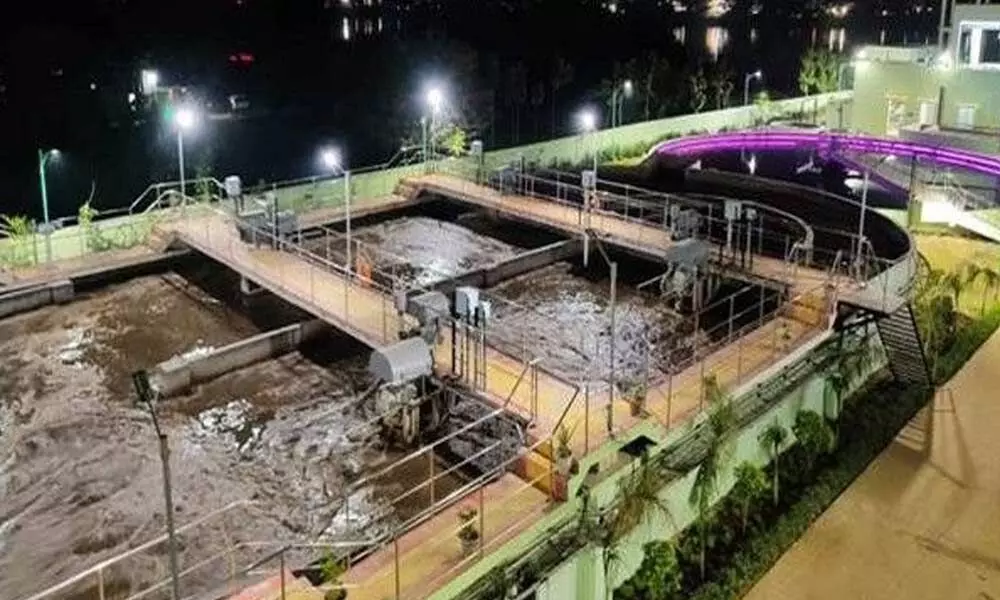Live
- Manipur violence: Assam Police mount 24x7 vigil along inter-state border
- The Impact of Wellness Programs on Employee Engagement and Retention
- IS claims responsibility for deadly attack in Afghanistan
- The Future of MSMEs: Embracing Innovation and Sustainability for Growth
- Army chief returns from Nepal after defence cooperation talks
- ‘Vikatakavi’ shines at IFFI, Goa
- Tamannaah highlights the strengths of south Indian cinema
- Shivanna’s ‘BhairathiRanagal’ locks Telugu release date
- Startup Ecosystem and Technology: Revolutionizing India’s Retail Fashion
- SDT’s ‘Satya’looks favorite at Filmfare Short Film Awards 2024
Just In

Govt looking to monetise treated sewage from Ganga
The government is looking at ways to monetise treated sewage and dirty water that is removed from the Ganga river and will soon start selling it to the Indian Oil Corporation Limited (IOCL), a senior official said. Approximately 12,000 million litres per day (MLD) of sewage is generated in the Ganga basin.
New Delhi: The government is looking at ways to monetise treated sewage and dirty water that is removed from the Ganga river and will soon start selling it to the Indian Oil Corporation Limited (IOCL), a senior official said. Approximately 12,000 million litres per day (MLD) of sewage is generated in the Ganga basin. Director general (DG) of National Mission for Clean Ganga (NMCG) Asok Kumar said the agency will start selling treated water to the IOCL in about a month.
"We are starting it with Mathura, a project for 20 MLD of treated water to be given to the IOCL. There is an oil refinery there and the treated water from the Mathura STP will be given as per the requirement of the IOCL. In one month or so we will be able to get that project and it will be the first time in the country that an oil refinery will be taking treated water," Kumar said. The dirty and sewage water collected from the Ganga will be treated in sewage treatment plants (STPs) and then it can be sold to industries as it is suitable for them, he said.
"The treated water, which is of good bathing standard, can be used by industries. It will also help in reducing usage of good water from rivers," he added. Kumar said earlier less treated water was generated for sale to industries as very few STPs were functional. "Some of them (STPs) did not even have a power connection, even though they had been completed many years back, which means that they were not running at all. And there was no close monitoring of the water that was coming to the STPs. But now that the STPs are in place and working, we can plan to monetise it (treated water)," he added.
The NMCG DG said the agency is also in talks with the Ayush ministry on how medicinal plants can be grown on river beds as part of natural farming. "We are also in talks with companies that can go for medicinal plant farming on the river bed so livelihood opportunities can be come up for farmers," he added. Kumar said now the focus of the NMCG is on 'Arth Ganga', which aims to connect people with the river and establish an economic linkage between them for sustenance.
"For the last two months, we have been working extensively on Arth Ganga to make that economic connect," he said. In 2015, the government launched the NMCG or 'Namami Gange', with an indicative cost of Rs 20,000 crore, as an umbrella programme with an aim to integrate previous and ongoing projects and new initiatives planned for cleaning the Ganga. Under the programme, a total of 347 projects were sanctioned against a cost of Rs 30,255 crore.
The projects comprise infrastructure and non-infrastructure development towards rejuvenating the Ganga. The projects directly related to the cleaning process include development of sewerage infrastructure, industrial effluent treatment plants, rural sanitation, and river surface cleaning.

© 2024 Hyderabad Media House Limited/The Hans India. All rights reserved. Powered by hocalwire.com







